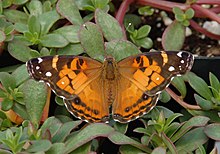
Hi Everybody!!
For Mother's Day I wanted to bring you millions of Butterflies! I ventured out to a field of wildflowers on a beautiful day to capture all the butterflies I could find! You get ONE. One lone butterfly was dining on the flowers. I do not know what has happened to all the butterflies. I only know the numbers are down, way down in this area. This was a very windy afternoon and the poor little guy was holding on for dear life, yet still sucking nectar from the flowers.
Enjoy the Surprise below!

https://en.wikipedia.org/wiki/American_Painted_Lady
American Painted Lady
From Wikipedia, the free encyclopedia
The American Painted Lady or American Lady (Vanessa virginiensis)[1] is abutterfly found throughout North America.
Vanessa virginiensis lives in flowery habitats, usually in mountains. The larvae feed on various Asteraceae, especially the cudweeds of genus Gnaphalium. All stages of the life cycle can be found throughout temperate North America as well as Madeiraand the Canary Islands. Occasionally individuals can be found as far as south-westEurope.
| American Painted Lady | |
|---|---|
 | |
| Scientific classification | |
| Kingdom: | Animalia |
| Phylum: | Arthropoda |
| Class: | Insecta |
| Order: | Lepidoptera |
| Family: | Nymphalidae |
| Genus: | Vanessa |
| Subgenus: | Cynthia |
| Species: | V. (C.) virginiensis |
| Binomial name | |
| Vanessa (Cynthia) virginiensis (Drury, 1773) | |
Description[edit]
Vanessa virginiensis is most easily distinguishable by its two large eyespots on the ventral side, whereas V. cardui has four small eyespots and V. annabella has none.V. virginiensis also uniquely features a white dot within the forewing subapical field, set in pink on the underside and usually also in the dorsal side's orange field.
The largest spot in the black forewing tips is white in V. cardui, pale orange in this species, and orange in the West Coast species. The latter also has a purer orange background color of the dorsal side, as opposed to the darker and (especially in V. virginiensis) redder hue of the other two.
A less reliable indicator is the row of black eyespots on the dorsal submarginal hindwing. In the American Painted Lady, those on the opposite ends of the row are often larger and have blue "pupils". In V. annabella, this applies to the inner two spots, while in V. cardui some of the black eyespots may have tiny blue pupils in the summer morph, but usually have none at all, and the eyespots themselves are all roughly the same size. The size of the wings are about 5 cm (2 in) across.

Nectaring on red clover.

Ventral side.
https://en.wikipedia.org/wiki/Painted_Lady#Distinguishing_features
Distinguishing features[edit]
- For a key to the terms used see Lepidopteran glossary
In general, the Painted Lady is a large butterfly (wing span 5–9 cm (2.0–3.5 in)) identified by the black and white corners of its mainly deep orange, black-spotted wings. It has five white spots in the black forewing tips and while the orange areas may be pale here and there, there are no clean white dots in them. The hindwings carry four small submarginal eyespots on dorsal and ventral sides. Those on the dorsal side are black, but in the summermorph sometimes small blue pupils are present in some. In Europe it migrates annually between North Africa, includingMorocco, and northern Europe, using a sun compass for orientation.[1] It was originally thought that the northward movement was a 'Pied Piper' migration, but evidence now exists for an autumn southwards return migration.[2]
The American Painted Lady (V. virginiensis) is most easily distinguishable by its two large hindwing eyespots on the ventral side. virginiensis also features a white dot within the subapical field of the forewings set in pink on the ventral side, and often as a smaller clean white dot in the orange of the dorsal side too. A less reliable indicator is the row of eyespots on the dorsal submarginal hindwing; virginiensis often has two larger outer spots with blue pupils. The black forewing tips have four to five white spots; usually the largest is whitish orange.
The West Coast Lady (V. annabella) does not have obvious ventral eyespots. On the dorsal side, anabella lacks a white dot in the subapical orange found in virginiensis, and is a purer orange color. V. annabella has a fully orange subapical band and leading edge on the forewing. The submarginal row of hindwing spots in annabella features three or four blue pupils. The two larger pupils in annabella are the inner spots, rather than the outer spots as in corresponding virginiensis.
The Australian Painted Lady (V. kershawi) is quite similar to V. cardui. Its four ventral eyespots are less clearly defined, and it always sports at least three (often four) blue pupil spots on its dorsal hindwing. Caterpillars are found mainly on Ammobium alatum.
Lifespan[edit]
The lifespan of a Painted Lady Butterfly is 2–4 weeks.



https://plus.google.com/u/0/photos/117645114459863049265/albums/6011808606055955409



Bonus Surprise Exercise for Mother's Day:
Try to stay on the flower and imagine yourself as the butterfly. Try to stay in the moment of what you see and hear. Just push Play:

...this is brendasue signing off from Rainbow Creek. See You next time! Happy Mother's Day!!

O+O

No comments:
Post a Comment
Hi Everybody! Please say hello and follow so I know you are here! Due to the inconsideration of people trying to put commercials on my blog comment area, I have restricted use of anonymous posts. Sorry that some hurt all.
My public email is katescabin@gmail.com No spammers or trolls